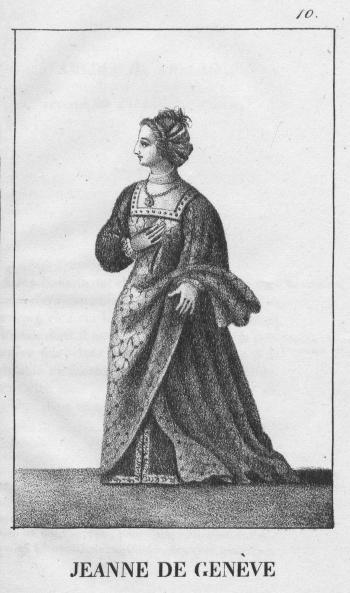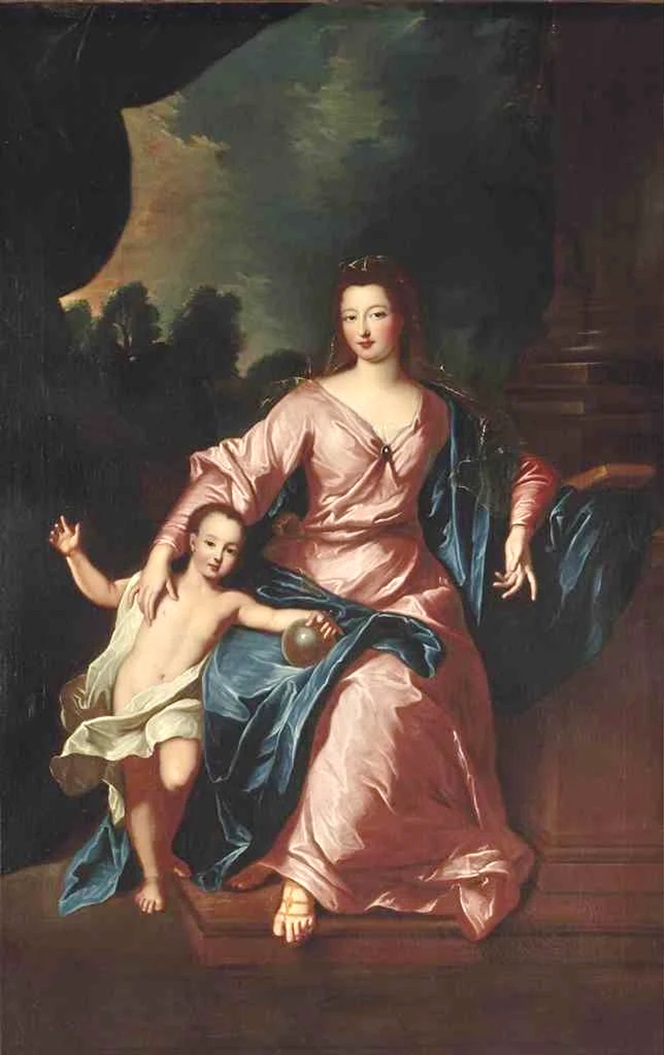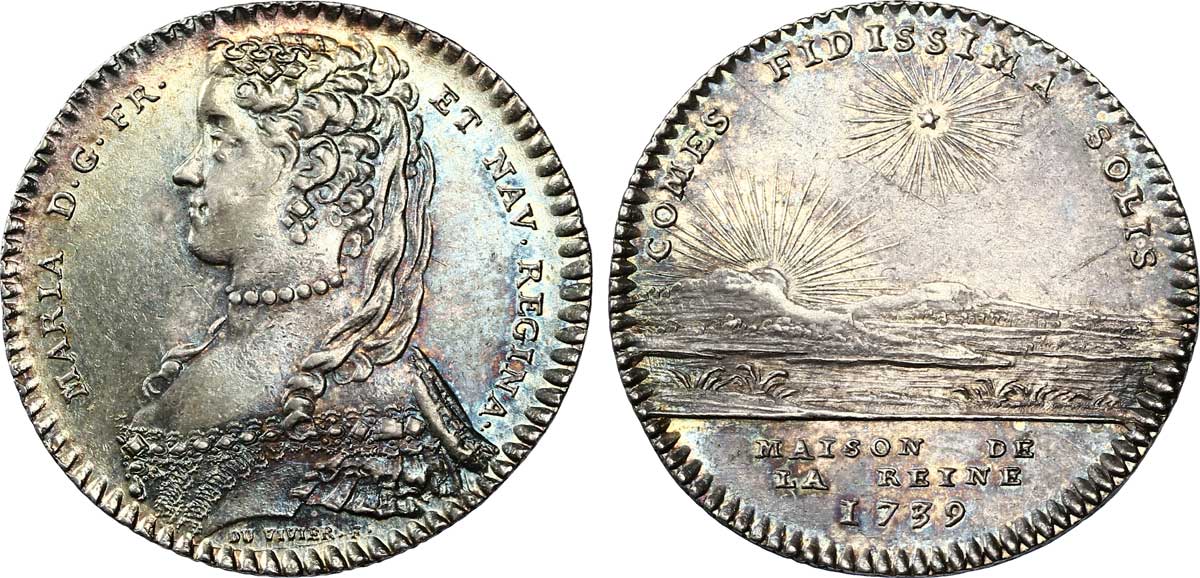|
Elisabeth Therese Of Lorraine
Elisabeth Therese of Lorraine (15 October 1711 3 July 1741) was Queen of Sardinia as the wife of Charles Emmanuel III of Sardinia. She was born a Princess of Lorraine as the daughter of Leopold, Duke of Lorraine and Élisabeth Charlotte d'Orléans. She became the ''coadjutor bishop'' of Remiremont Abbey in 1734, before her marriage to Charles Emmanuel III. She died from puerperal fever, after childbirth. Early life (1711–1736) Princess Elisabeth Therese was born on 15 October 1711 at the Château de Lunéville in Lorraine. She was the seventh daughter and eleventh child of Leopold Joseph of Lorraine and his wife, Élisabeth Charlotte d'Orléans. As a Princess of Lorraine, she was entitled to the style of ''Highness'' as well as the rank of ''foreign princess'' in France. During the coronation of Louis XV in October 1722, Elisabeth Therese, her mother, and her sisters Anne Charlotte and Marie Louise went to the French royal court. Elisabeth Therese's grandmother, Princess ... [...More Info...] [...Related Items...] OR: [Wikipedia] [Google] [Baidu] |
Queen Consort Of Sardinia
This is a list of consorts of the Savoyard monarchs. Countess of Savoy, 1003–1416 Duchess of Savoy, 1416–1713 ;As courtesy title Queen of Sardinia, 1720–1861 Between 1859 and 1861 the Kingdom of Sardinia incorporated the majority of Italian states. On 17 March 1861 King Victor Emmanuel II was proclaimed King of Italy King of Italy ( it, links=no, Re d'Italia; la, links=no, Rex Italiae) was the title given to the ruler of the Kingdom of Italy after the fall of the Western Roman Empire. The first to take the title was Odoacer, a barbarian military leader ... by the Parliament in Turin. Queen of Italy, 1861–1946 Duchess of Savoy, post 1946 (''monarchy abolished)'' Notes SourcesSAVOY {{Italian royal titles # House of Savoy Savoyard, consorts Savoyard, consorts Savoyard, consorts Savoyard, consorts ... [...More Info...] [...Related Items...] OR: [Wikipedia] [Google] [Baidu] |
Queen Of Sardinia
This is a list of consorts of the Savoyard monarchs. Countess of Savoy, 1003–1416 Duchess of Savoy, 1416–1713 ;As courtesy title Queen of Sardinia, 1720–1861 Between 1859 and 1861 the Kingdom of Sardinia incorporated the majority of Italian states. On 17 March 1861 King Victor Emmanuel II was proclaimed King of Italy King of Italy ( it, links=no, Re d'Italia; la, links=no, Rex Italiae) was the title given to the ruler of the Kingdom of Italy after the fall of the Western Roman Empire. The first to take the title was Odoacer, a barbarian military leader, ... by the Parliament in Turin. Queen of Italy, 1861–1946 Duchess of Savoy, post 1946 (''monarchy abolished)'' Notes SourcesSAVOY {{Italian royal titles # House of Savoy Savoyard, consorts Savoyard, consorts Savoyard, consorts Savoyard, consorts ... [...More Info...] [...Related Items...] OR: [Wikipedia] [Google] [Baidu] |
Duchy Of Lorraine
The Duchy of Lorraine (french: Lorraine ; german: Lothringen ), originally Upper Lorraine, was a duchy now included in the larger present-day region of Lorraine in northeastern France. Its capital was Nancy. It was founded in 959 following the division of Lotharingia into two separate duchies: Upper and Lower Lorraine, the westernmost parts of the Holy Roman Empire. The Lower duchy was quickly dismantled, while Upper Lorraine came to be known as simply the Duchy of Lorraine. The Duchy of Lorraine was coveted and briefly occupied by the dukes of Burgundy and the kings of France. In 1737, the duchy was given to Stanisław Leszczyński, the former king of Poland, who had lost his throne as a result of the War of the Polish Succession, with the understanding that it would fall to the French crown on his death. When Stanisław died on 23 February 1766, Lorraine was annexed by France and reorganized as a province. History Lotharingia Lorraine's predecessor, Lotharingia, was a ... [...More Info...] [...Related Items...] OR: [Wikipedia] [Google] [Baidu] |
Charles VI, Holy Roman Emperor
, house = Habsburg , spouse = , issue = , issue-link = #Children , issue-pipe = , father = Leopold I, Holy Roman Emperor , mother = Eleonore Magdalene of Neuburg , birth_date = , birth_place = Hofburg Palace, Vienna , death_date = , death_place = Palais Augarten, Vienna , place of burial = Imperial Crypt , signature = Signatur Karl VI. (HRR).PNG , religion = Roman Catholicism Charles VI (german: Karl; la, Carolus; 1 October 1685 – 20 October 1740) was Holy Roman Emperor and ruler of the Austrian Habsburg monarchy from 1711 until his death, succeeding his elder brother, Joseph I. He unsuccessfully claimed the throne of Spain following the death of his relative, Charles II. In 1708, he married Elisabeth Christine of Brunswick-Wolfenbüttel, by whom he had his four children: Leopold Johann (who died in infancy), Maria Theresa (the last direct Habsburg sovereign), Mar ... [...More Info...] [...Related Items...] OR: [Wikipedia] [Google] [Baidu] |
Heiress Apparent
An heir apparent, often shortened to heir, is a person who is first in an order of succession and cannot be displaced from inheriting by the birth of another person; a person who is first in the order of succession but can be displaced by the birth of a more eligible heir is known as heir presumptive. Today these terms most commonly describe heirs to hereditary titles (e.g. titles of nobility) or offices, especially when only inheritable by a single person. Most monarchies refer to the heir apparent of their thrones with the descriptive term of ''crown prince'' or ''crown princess'', but they may also be accorded with a more specific substantive title: such as Prince of Orange in the Netherlands, Duke of Brabant in Belgium, Prince of Asturias in Spain (also granted to heirs presumptive), or the Prince of Wales in the United Kingdom; former titles include Dauphin in the Kingdom of France, and Tsesarevich in Imperial Russia. The term is also used metaphorically to indicate a ... [...More Info...] [...Related Items...] OR: [Wikipedia] [Google] [Baidu] |
Maria Theresa
Maria Theresa Walburga Amalia Christina (german: Maria Theresia; 13 May 1717 – 29 November 1780) was ruler of the Habsburg dominions from 1740 until her death in 1780, and the only woman to hold the position ''suo jure'' (in her own right). She was the sovereign of Austria, Hungary, Croatia, Bohemia, Transylvania, Mantua, Milan, Lodomeria and Galicia, the Austrian Netherlands, and Parma. By marriage, she was Duchess of Lorraine, Grand Duchess of Tuscany and Holy Roman Empress. Maria Theresa started her 40-year reign when her father, Emperor Charles VI, died on 20 October 1740. Charles VI paved the way for her accession with the Pragmatic Sanction of 1713 and spent his entire reign securing it. He neglected the advice of Prince Eugene of Savoy, who believed that a strong military and a rich treasury were more important than mere signatures. Eventually, Charles VI left behind a weakened and impoverished state, particularly due to the War of the Polish Succession and the Rus ... [...More Info...] [...Related Items...] OR: [Wikipedia] [Google] [Baidu] |
Louis, Duke Of Orléans (1703–1752)
Louis, Duke of Orléans (4 August 1703 – 4 February 1752) was a member of the House of Bourbon, and as such was a '' prince du sang''. At his father's death, he became the First Prince of the Blood (''Premier Prince du Sang'') and Duke of Orléans. Known as Louis le Pieux and also as Louis le Génovéfain, Louis was a pious, charitable and cultured prince, who took very little part in the politics of the time. Early years Louis d'Orléans was born at the Palace of Versailles in 1703 to Philippe II, Duke of Orléans and his wife, Françoise Marie de Bourbon, the youngest legitimised daughter of Louis XIV and of his mistress Madame de Montespan. He was the only son of eight children, and at his birth, he was given the courtesy title of Duke of Chartres as the heir to the Orléans fortune and titles. His maternal grandfather, King Louis XIV of France, in addition gave him the allowance reserved for the First Prince of the Blood, a rank he was not yet eligible to hold. He was b ... [...More Info...] [...Related Items...] OR: [Wikipedia] [Google] [Baidu] |
Edmond De Goncourt
Edmond Louis Antoine Huot de Goncourt (; 26 May 182216 July 1896) was a French writer, literary critic, art critic, book publisher and the founder of the Académie Goncourt. Biography Goncourt was born in Nancy. His parents, Marc-Pierre Huot de Goncourt and Annette-Cécile de Goncourt (née Guérin) were minor aristocrats who died when he and his brother Jules de Goncourt were young adults. His father was a former cavalry officer and squadron commander in the Grande Armée of Napoleon I, and his grandfather Jean-Antoine Huot de Goncourt had been a deputy in the National Assembly of 1789. Edmond attended the pension Goubaux, the Lycée Henri IV, and the Lycée Condorcet. At the Lycée Condorcet, he studied rhetoric and philosophy from 1840 to 1842, followed by the study of law between 1842 and 1844. After their mother's death in 1848, the brothers inherited an income which enabled them to live independently and pursue their artistic interests. Edmond was able to leave a treasur ... [...More Info...] [...Related Items...] OR: [Wikipedia] [Google] [Baidu] |
House Of Habsburg
The House of Habsburg (), alternatively spelled Hapsburg in Englishgerman: Haus Habsburg, ; es, Casa de Habsburgo; hu, Habsburg család, it, Casa di Asburgo, nl, Huis van Habsburg, pl, dom Habsburgów, pt, Casa de Habsburgo, la, Domus Habsburg, french: Maison des Habsbourg and also known as the House of Austriagerman: link=no, Haus Österreich, ; es, link=no, Casa de Austria; nl, Huis van Oostenrijk, pl, dom Austrii, la, Domus Austriæ, french: Maison d'Autriche; hu, Ausztria Háza; it, Casa d'Austria; pt, Casa da Áustria is one of the most prominent and important dynasties in European history. The house takes its name from Habsburg Castle, a fortress built in the 1020s in present-day Switzerland by Radbot of Klettgau, who named his fortress Habsburg. His grandson Otto II was the first to take the fortress name as his own, adding "Count of Habsburg" to his title. In 1273, Count Radbot's seventh-generation descendant Rudolph of Habsburg was elected King of the ... [...More Info...] [...Related Items...] OR: [Wikipedia] [Google] [Baidu] |
Marie Leszczyńska
Maria Karolina Zofia Felicja Leszczyńska (; ; 23 June 1703 – 24 June 1768), also known as Marie Leczinska, was Queen of France as the wife of King Louis XV from their marriage on 4 September 1725 until her death in 1768. The daughter of Stanisław Leszczyński, the deposed King of Poland, and Catherine Opalińska, her 42-years and 9 months service was the longest of any queen in French history. A devout Roman Catholic throughout her life, Marie was popular among the French people for her numerous charitable works and introduced many Polish customs to the royal court at Versailles. She was the grandmother of the French kings Louis XVI, Louis XVIII and Charles X. Early life Born as a member of the House of Leszczyński, Maria Karolina Zofia Felicja Leszczyńska ( Wieniawa) was the second daughter of Stanislaus I Leszczyński and his wife, Countess Catherine Opalińska. She had an elder sister, Anna Leszczyńska, who died of pneumonia in 1717. Maria's early life was troubled ... [...More Info...] [...Related Items...] OR: [Wikipedia] [Google] [Baidu] |
Louis Henri, Duke Of Bourbon
Louis Henri, Duke of Bourbon (Louis Henri Joseph; 18 August 1692 – 27 January 1740), was a French nobleman and politician who served as Prime Minister of France from 1723 to 1726. As a member of the reigning House of Bourbon, he was a '' prince du sang''. Louis Henri was the second child and eldest son of Louis III, Prince of Condé, and Louise Françoise de Bourbon, the eldest daughter of King Louis XIV and his mistress Madame de Montespan. Following the death of his father in 1710, he became head of the Bourbon-Condé cadet branch of the House of Bourbon. As such, he was entitled to be known as Prince of Condé, but he used the title Duke of Bourbon instead and was known at court as ''Monsieur le Duc''. After his maternal grandfather died in 1715, Louis Henri became a member of the regency council led by Philippe II, Duke of Orléans, the regent for the new minor king Louis XV. In 1723, Louis Henri succeeded the Duke of Orléans as chief minister to Louis XV. He nego ... [...More Info...] [...Related Items...] OR: [Wikipedia] [Google] [Baidu] |
Mariana Victoria Of Spain
Mariana Victoria of Spain ( pt, Mariana Vitória; 31 March 1718 – 15 January 1781) was an '' Infanta of Spain'' by birth and was later the Queen of Portugal as wife of King Joseph I. She acted as regent of Portugal in 1776–1777, during the last months of her husband's life and as advisor to her daughter, Maria I of Portugal, in her reign. Early life Mariana Victoria was born at the Royal Alcazar of Madrid in Madrid and was given the same forenames as her paternal grandmother Maria Anna Victoria of Bavaria, wife of ''Le Grand Dauphin''. She was an '' Infanta of Spain'' by birth and the eldest daughter of Philip V of Spain and his second wife Elisabeth Farnese. Her father was a grandson of Louis XIV and had inherited the Spanish throne in 1700. At the time of her birth, Mariana Victoria was fifth in line to the throne of Spain behind her half brothers Infante Louis, Prince of Asturias, Infante Ferdinand, Infante Pedro as well as her full brother Infante Charles. As an ''I ... [...More Info...] [...Related Items...] OR: [Wikipedia] [Google] [Baidu] |











